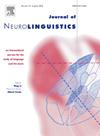语言产生过程中语音监测背后的脑交互作用
IF 1.2
3区 心理学
Q2 LINGUISTICS
引用次数: 0
摘要
本研究调查了7名接受立体定向脑电图(SEEG)监测和参与图像-文字干扰(PWI)任务的癫痫患者支持言语监测的脑区之间的功能连接模式。利用图信号处理(GSP)技术,我们发现先前与语音监测过程相关的三个大脑区域,即前扣带皮层(ACC)、颞上回(STG)和脑岛,在发声开始时相互作用,并且这些连接在错误试验中比正确试验中更可能发生。此外,它们参与功能连接指标的时间表明,它们在内部和外部语音监测中发挥着不同但互补的作用。具体来说,前扣带皮层在发声前后保持恒定的连接模式,这表明它在主动和反应性言语监测中起着持续的作用。STG在发声后表现出更强的连通性,与其处理听觉反馈和外部监测的作用一致。相反,脑岛在发声前比发声后表现出更强的连通性,这表明它在发音规划和内部言语监控中发挥作用。我们的研究结果与语言产生过程中基于冲突的语音监控相符,并表明内部和外部语音监控是由网络关键大脑区域之间的动态相互作用支持的。本文章由计算机程序翻译,如有差异,请以英文原文为准。
Brain interactions underlying speech monitoring in language production
This study investigates functional connectivity patterns between brain regions supporting speech monitoring in seven participants with epilepsy undergoing stereotactic electroencephalographic (SEEG) monitoring and participating in a picture-word interference (PWI) task. Using graph signal processing (GSP) techniques, we found that three brain regions previously associated with speech monitoring processes, namely the anterior cingulate cortex (ACC), superior temporal gyrus (STG), and insula, functionally interact with each other and other regions around vocal onset and that these connections are more probable in errors than correct trials. Furthermore, the timing of their involvement in functional connectivity metrics indicates that they play distinct yet complementary roles in inner and outer speech monitoring. Specifically, the ACC maintains constant connectivity patterns before and after vocal onset, suggesting a continuous role in proactive and reactive speech monitoring. The STG shows stronger connectivity after vocal onset, consistent with its role in processing auditory feedback and external monitoring. Conversely, the insula exhibits stronger connectivity before vocal onset than after, suggesting that it plays a role in articulatory planning and inner speech monitoring. Our results align with the conflict-based account of speech monitoring in language production and suggest that inner and outer speech monitoring are supported by dynamic interactions between key brain regions of a network.
求助全文
通过发布文献求助,成功后即可免费获取论文全文。
去求助
来源期刊

Journal of Neurolinguistics
医学-神经科学
CiteScore
3.90
自引率
5.00%
发文量
49
审稿时长
17.2 weeks
期刊介绍:
The Journal of Neurolinguistics is an international forum for the integration of the neurosciences and language sciences. JNL provides for rapid publication of novel, peer-reviewed research into the interaction between language, communication and brain processes. The focus is on rigorous studies of an empirical or theoretical nature and which make an original contribution to our knowledge about the involvement of the nervous system in communication and its breakdowns. Contributions from neurology, communication disorders, linguistics, neuropsychology and cognitive science in general are welcome. Published articles will typically address issues relating some aspect of language or speech function to its neurological substrates with clear theoretical import. Interdisciplinary work on any aspect of the biological foundations of language and its disorders resulting from brain damage is encouraged. Studies of normal subjects, with clear reference to brain functions, are appropriate. Group-studies on well defined samples and case studies with well documented lesion or nervous system dysfunction are acceptable. The journal is open to empirical reports and review articles. Special issues on aspects of the relation between language and the structure and function of the nervous system are also welcome.
 求助内容:
求助内容: 应助结果提醒方式:
应助结果提醒方式:


